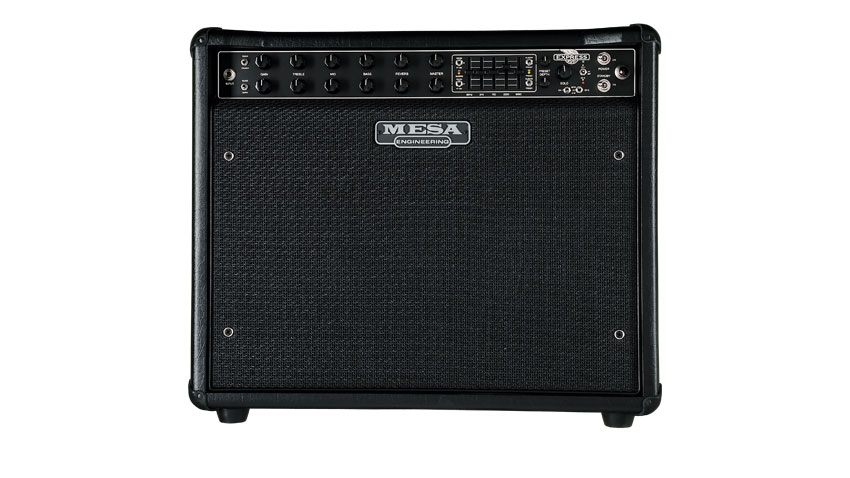MusicRadar Verdict
Useful and worthwhile upgrades to a class-leading all-rounder.
Pros
- +
Huge versatility in both sonic and practical terms. Well-priced in today's market.
Cons
- -
Not everyone requires this level of complexity.
MusicRadar's got your back
Back in 2007, Mesa launched the Express Series, superseding the F Series as the most affordable entry-point in its amplifier catalogue. 2012 saw the company tweak this popular line, and here is the 5:50 combo in its new 'Plus' incarnation.
"The new Plus models have a re-engineered clean mode that promises additional high-end sparkle and warmer low-end"
New to the Plus models is a re-engineered clean mode that incorporates some of Mesa's Lone Star circuitry, and promises both additional sparkle in the high-end and a warmer low-end, with a "significantly better" signal- to-noise ratio.
Alongside the original Express models' preset contour controls, which provide a sweep of the company's classic V-shaped EQ, Mesa has added its prized five-band graphic equaliser here, allowing for more detailed fine-tuning. This can be assigned to each channel or bypassed completely if that is your preference.
There's also an additional Solo control, enabling a preset master boost to be engaged, to help your lead breaks cut through the mix. An included four-button footswitch gives you on-the-fly access to channel switching, reverb, the five-band EQ and solo boost.
"The headline-grabbing feature is the inclusion of Mesa's patented Multi-Watt channel-assignable power switching"
Perhaps the most significant, headline-grabbing feature of the new Plus models is the inclusion of Mesa's patented Multi-Watt channel-assignable power switching , which features 'Duo-Class' technology.
In practical terms, this means that each channel has three independent power settings that alter the output, headroom and dynamic characteristics in the following way: full tilt sees the amplifier operating in push-pull Class AB, with the 5:50 kicking out 50 watts. Flip down to 25 watts and the channel in question will run in Class A pentode mode. There's also a third, five-watt mode that runs one valve (an 6L6) in a single-ended, Class A triode configuration.
Although there's no shortage of online pedantry from electronics purists who argue that very few guitar amplifier circuits run in anything like true Class A, the overwhelming majority of prospective buyers of these amps will be interested in whether the sonic and dynamic characteristics cut the mustard for stage and studio use, rather than quibbling about definitions.
In the case of the combo here, Mesa has managed to pack a hugely impressive amount of functionality into a relatively compact enclosure. Built to Mesa's expected high standards in the company's Petaluma, California facility, it gives us no reason to question its road-worthiness.
Sounds
"Powering up and engaging channel one's clean mode on full power, there's no mistaking the Californian accent of the amplifier"
Powering up and engaging channel one's clean mode on full power, there's no mistaking the Californian accent of the amplifier. There's plenty of 'blackface' Fender in the DNA of this model and the 5:50's power translates into a massive Twin- style clean voice with piano-like bass, but a softer, more rounded modern high-end personality than the class of '65.
Admittedly, the 5:50's stage-filling punch is massively overpowered for most normal real-world gig venues, but that's where the power-scaling comes in: great for players who like to live on the edge of break-up without breaking glass.
Flipping over to Crunch mode, the amp delivers a more midrange-y tonality that's just the ticket for sinewy roots and classic rock, older blues styles and even hard rock at the upper end of the gain spectrum, particularly with judicious use of the five-band EQ to taste. Given the tonal versatility across both voices of channel one, and the small-amp-to-big-amp power scaling options, this channel alone would be more than enough amp for many players, yet it's only half of the story.
Flipping over to channel two in Blues mode, you'll find a voice that's much more Gary Moore than Muddy Waters when it comes to the level of gain available. However, don't discount the highly musical tones that are available when you dial the dirt back. Channel two doesn't have to be your dirty channel - indeed, one of the most versatile combinations we found for stage use had channel two's Blues mode dialled in for edgy cleans, and channel one's Crunch mode set up for dirtier lead excursions.
"If high-gain is your thing and you are a fully paid-up worshipper at the black altar, the duo of 6L6s combine to deliver the gut punch you need"
If high-gain is your thing and you are a fully paid-up worshipper at the black altar, when channel two is set to Burn the 5:50's Celestion C90 driver, cabinet inches and duo of 6L6s combine to deliver the gut punch you need, with tightness and headroom to spare, at 25 and 50 watts.
It's also got that modern Boogie characteristic of a slightly soft attack when compared to the fast response of many vintage-style hand-wired circuits, with a smoothness that almost feels like some light studio compression has been applied somewhere in the signal chain.
The reverb is smooth and soupy, too, and it's very forgiving, dynamically, but this is still an amp that may take a little getting used to.
If you're in the market for the ultimate compact, do-it-all combo and money is no object, we wouldn't hesitate in recommending the Gold Award-winning Mesa/Boogie Mark V. However, it's well over two grand at current street prices, and thus too damn expensive for most of us.
The tweaks to the Express Series bring this new Plus amplifier significantly closer to the massive versatility of the Mark V, for a lot less cash.
For the majority of players, the smaller 5:25 sister model will be a consideration and that amp delivers a whole lotta grin for the money. But the 5:50 gives you all that and more, and if high levels of amp gain are a major part of your sound, then the additional punch of the 5:50 makes it the logical choice. It's never not going to be enough amp, that's for sure.
Chris Vinnicombe worked with us here on the MusicRadar team from the site's initial launch way back in 2007, and also contributed to Guitarist magazine as Features Editor until 2014, as well as Total Guitar magazine, amongst others. These days he can be found at Gibson Guitars, where he is editor-in-chief.

“Instead of pairing a new booster inside this new pedal, think of it as changing lanes inside the pedal”: Mythos and That Pedal Show team up for the Argo Boost Deluxe – an octave fuzz with a switchable boost

“I didn’t even realise it had synthesizer on it for decades”: This deep dive into The Beatles' Here Comes The Sun reveals 4 Moog Modular parts that we’d never even noticed before

“I saw people in the audience holding up these banners: ‘SAMMY SUCKS!' 'WE WANT DAVE!’”: How Sammy Hagar and Van Halen won their war with David Lee Roth










